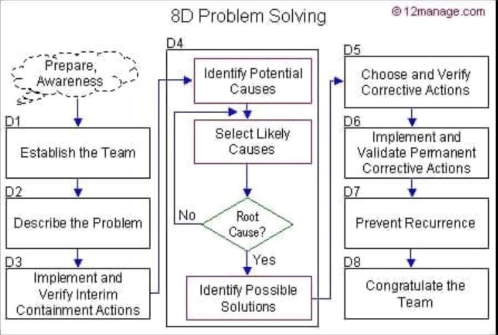
The 8D methodology (8D=eight disciplines) was developed in Ford Motor Company in the mid-1980s to be used by their suppliers to improve the resolution of problems. It appears in a variety of forms used to define eight disciplines. Sometimes it is defined as a nine-step problem-solving process.
Because the 8D model is designed to solve specific problems that arise, more emphasis is placed on containing the problem (discipline 3) than in most other frameworks.
The idea is to implement intermediate actions that will protect the customer from the problem until a permanent solution can be developed and implemented.
The Eight Steps of the 8D Methodology
The 8D Methodology was originally composed of eight “disciplines” or steps. In the 1980’s Ford added a ninth discipline, planning, but the name “8D” was retained.
The disciplines are:
D0 – Plan
D1 – Put Together A Team
D2 – Define the Problem
D3 – Implement a Temporary Fix
D4 – Identify Root Causes and Chose a Solution
D5 – Confirm The Solution Resolves The Problem
D6 – Fully Implement the Solution
D7 – Prevent Recurrence
D8 – Recognize the Team
The 8D Methodology is based on the #PDCA Cycle (Plan, Do, Check, Act). Each step in PDCA roughly corresponds to two steps in 8D Methodology:
Plan – Define a problem and hypothesize possible causes and solutions (8D steps D0-D2).
Do – Implement a solution (8D steps D3-D4).
Check – Evaluate the results (8D steps D5-D6).
Act – Either return to the planning step, or standardize the solution, depending on the results (8D steps D7-D8).

 Follow
Follow